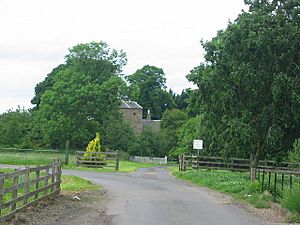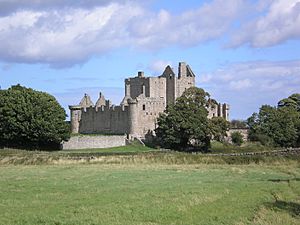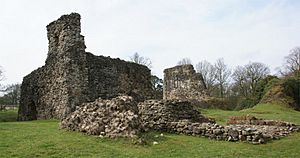Barbara Napier facts for kids
Barbara Napier was a Scottish woman who lived a long time ago, in the late 1500s. She became famous because she was involved in the North Berwick witch trials in 1591. These were a series of trials where many people were accused of witchcraft.
Barbara was accused of talking to witches and was found guilty of this. However, it's not completely clear what happened to her afterward, unlike some others who were executed.
Contents
Early Life and Family
Barbara Napier might have been related to William Napier of Wrychtishousis, which was a castle near Edinburgh. She first married a bookseller named George Ker in 1572. After he passed away in 1576, she married Archibald Douglas, who was an important citizen of Edinburgh. Her family included a son and a daughter named Janet Douglas.
People at the time, like the writer David Moysie, said that Barbara Napier and another accused woman, Euphame MacCalzean, were "wemen of guid reputation afoir." This means they were well-respected members of society before they were accused. Other writings also mentioned their good standing in the community.
The witchcraft accusations in 1591 were linked to King James VI's journey to meet his future wife, Anne of Denmark. This journey faced "contrary winds" (bad weather), which some people thought was caused by witchcraft. The accusations against Barbara Napier also related to her husband's actions against John Maxwell, 8th Lord Maxwell in 1588. Barbara was also connected to Archibald Douglas, 8th Earl of Angus and his wife, Jean Lyon, Countess of Angus. The accusations against her were written down as "articles of dittay," which are like a list of charges.
William Napier's Connections
William Napier of Wrichtishousis, who might have been Barbara's relative, was also involved in interesting events. In 1590, he and James Lumsden delivered a valuable royal jewel to the Privy Council. They had received this diamond from the Countess of Angus, who had used it to get a loan. They didn't know it was a royal jewel. This jewel might have been one of the jewels of Mary, Queen of Scots that had been used for loans many years before. William Napier was also a merchant and helped return Spanish sailors who were stranded in Scotland after the defeat of the Spanish Armada in 1588.
Witchcraft Accusations Against Barbara

One of the main accusations against Barbara Napier came from Geillis Duncan, another woman accused of witchcraft. Geillis claimed that Barbara Napier had caused the illness of Archibald Douglas, 8th Earl of Angus. The Earl became very sick and passed away in 1588. It was said that witches caused his death by making a wax image of him and melting it by a fire.
Another person, Donald Robinson, confessed that Barbara Napier, Euphame MacCalzean, Agnes Sampson, and others had met at a place called "Atkynson's or Acheson's Haven." There, they supposedly passed around an image of King James VI and gave it to the devil to harm the king.
Barbara Napier was also accused of buying charms to help her own health and to improve her relationship with Jean Lyon, Countess of Angus. She hoped that Agnes Sampson could stop Jean Lyon's morning sickness. Agnes Sampson was also said to have given Barbara Napier a special ring with a stone that would help her win Jean Lyon's friendship. Agnes Sampson and Barbara Napier met in places like Dalkeith and "Camroune-brig-end" near the Braid Burn to talk.

Napier was also accused of asking Agnes Sampson to use magic to protect her husband. This was when her husband was serving in the military against the Maxwell family during the "Raid of Dumfries" and at the siege of Lochmaben Castle in 1588.
Sampson was also said to have made a charmed wax image to harm an enemy of Barbara Napier and her husband, a man called "Archie." This image was placed in a dovecote (a small house for pigeons) at Craigmillar Castle Park.
Barbara Napier was accused of paying for these magical consultations with gifts like a linen headcover and pieces of cloth.
Trial and Outcome
The English ambassador in Edinburgh, Robert Bowes, heard that Barbara Napier and others were accused of trying to kill the king and the Earl of Angus using witchcraft. Her trial was set for April 12.
The jury at her trial found her guilty only of the lesser accusation: consulting with witches. They did not find her guilty of making an image of the Earl of Angus or attending the witch meeting at North Berwick. This was because the evidence against her mainly came from people who had already been found guilty of witchcraft. King James VI himself noted that there was "no testimony but of witches."

King James VI was not happy with this verdict. On May 10, 1591, he ordered that her execution should happen quickly. When her sentence was announced, Barbara Napier claimed she was pregnant. King James then ordered doctors to examine her to see if she was truly pregnant. If she wasn't, he wanted her to be executed. The king was very determined to get a different outcome for her trial, especially because he wanted to use these trials to prosecute Francis Stewart, 5th Earl of Bothwell, who was also accused of witchcraft.
The king even spoke to the jurors who had made the first decision. They eventually agreed with his views and were pardoned for their "error."
Barbara Napier's final fate is not entirely clear. Records show that materials were bought for her execution fire, but these were later used for the execution of Euphame MacCalzean on June 25, 1591. Some historians believe that Barbara Napier was eventually released. Her property was taken by the crown, but it was later arranged for her daughter to receive it back.


